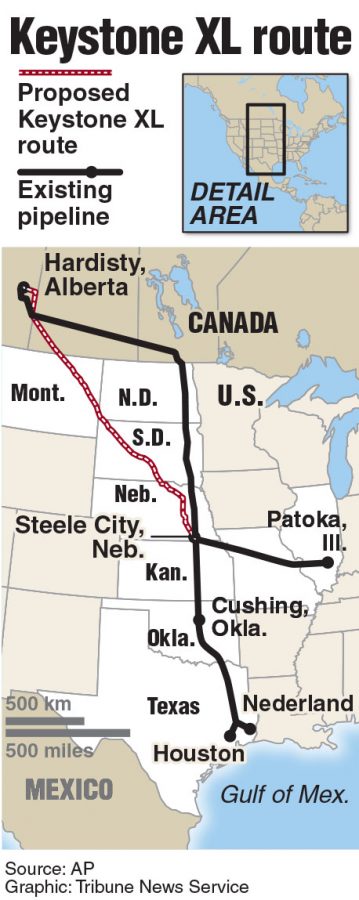Keystone XL pipeline granted historic win in Nebraska
In a 3-2 vote on Nov. 20 the Nebraska Public Service Commission moved to allow TransCanada’s Keystone XL pipeline to continue construction through the state of Nebraska. The decision is considered a win for the Trump Administration, which supported progress of the pipeline.
Commissioned in 2008, TransCanada Cooperation proposed the Keystone XL pipeline to carry oil 3,500 miles from Alberta, Canada to refineries in Port Arthur, Texas.
President Trump, four days into his presidency, reversed an Obama-era rejection of phase four of the project calling the pipeline “the greatest technology known to man or woman.”
Controversy has surrounded the pipeline in the past three years, delaying its construction and altering the pipeline’s path, which is broken up into phases one through four. Currently, phases one through three are in varying stages of completion, while phase four is in the proposal stage.
If completed, the Keystone XL pipeline would transport up to 830,000 barrels of petroleum a day from the oil sands of Alberta to U.S.-owned refineries in Texas.
Proponents of the Keystone XL pipeline point to the economic benefits they see resulting from the pipeline’s construction. The State Department estimates that up to 42,000 jobs could be created as a result of the Keystone pipeline, though only 35 of the jobs would be permanent.
The majority of jobs contributed to the workforce as a result of the Keystone pipeline construction would be temporary, but the economic impact of the construction would add an estimated $3.4 billion dollars to the United States economy.
There is steep opposition to the construction of the pipeline from a range of groups within the United States, including environmental activists and, most notably in the past year, the Standing Rock Sioux tribe, which gained national attention for its opposition to the Dakota Access Pipeline—another oil pipeline built to move oil from Canada to the U.S.
Concerns surrounding the Keystone XL pipeline are centered on the potential environmental impacts that can come from oil spills which opponents of the construction say could contaminate drinking water of local populations around the pipeline.
Environmental experts largely agree that blocking the continuation of construction on the Keystone pipeline will not be a large contributor in the fight against climate change because the emissions that come from extracting and moving the oil sands are not, themselves, a large contributor to environmental pollution.
Proponents and opponents of the pipeline will be looking towards the Bureau of Land Management in the coming months, as continuation of the pipeline on federal lands will be dependent on special permits given by the agency.












Dyanna Capaldi • Nov 5, 2021 at 12:36 pm
We the people and Congress should have Railed against the horrible Biden effects I know should of would’ve ……. Etc
The demon Dems took full advantage of our grief is the loss of our beloved President Trump